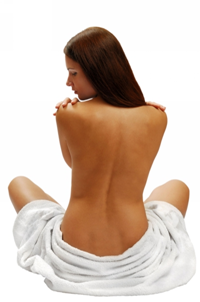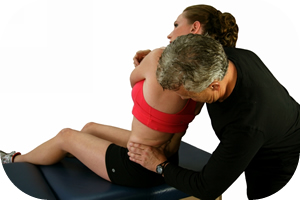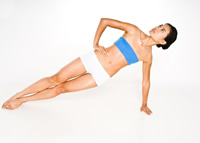Resolving Back and Neck Pain
 Neck and back pain can be caused by a wide variety of conditions and situations. One of the most common reasons patients come to our clinic is sprain/strain injuries of the neck and back.
Neck and back pain can be caused by a wide variety of conditions and situations. One of the most common reasons patients come to our clinic is sprain/strain injuries of the neck and back.
Sprain and Strain Injuries of the Neck and Back
Sprain/strain injuries can occur anywhere along the length of the spine – from the neck down to the tail-bone. The most common sprain/strain injuries occur in the low back, and account for up 60% of all back injuries. Since the majority of load- bearing forces are concentrated at the base of the spine, the lumbar vertebrae (L4 to L5 and L5 to S1) become particularly susceptible to injury.
What is a Sprain or Strain Injury?
Sprains and strains often occur together, but are actually injuries that occur to different parts of your body, and that have different impacts on your body.
Sprains
Sprains are injuries to ligaments (tough, fibrous tissues connecting bone-to-bone, and act to limit excessive movement within a joint). Ligaments provide stability through all ranges of motion. Sprains in the spinal column occur when a spinal ligament is stretched or torn from its attachment site.
- Grade-One Sprain (Minor): Involves minor tearing of the ligaments, with no resulting joint instability and minimal bruising.
- Grade-Two Sprain (Moderate): Involves more partial tearing of the ligaments, with bruising, pain, swelling, and some loss of functional activities.
- Grade-Three Sprain (Severe): Involves a complete tear of the ligament, with severe pain, bruising, swelling, and loss of function.
Grade-Three sprains often require surgical intervention for resolution. All other grades of sprain can be treated with a combination of ART and rehabilitative exercises.
Strains
Strains describe injuries to muscles and tendons (tough fibrous bands that connect muscle to bone). Strains typically occur when muscle or tendon fibres are over-stretched or torn. This most often occurs with muscles that cross joints.
- Grade-One Strain (Minor): Involves minimal stretching and tearing of muscle fibres. These usually heal within a few weeks.
- Grade-Two Strain (Moderate): Involves more damage to muscle fibres, but does not include complete rupture of the muscle. Healing occurs within three to six weeks.
- Grade-Three Strain (Severe): Involves a complete rupture of a muscle. This type of injury requires surgical intervention, with post-surgery healing taking up to three months.
Impact of Sprains and Strains on the Nervous System
Sprain/strain injuries affect much more than just the muscles, tendons, or ligaments that were initially damaged. Often, these injuries also affect the embedded neurological structures (Golgi tendon organs, muscle spindles, joint receptors, and nerves) that lie within these soft tissues. Click on each of the following tabs for more information about how we work with you to heal your back or neck injury.
Golgi Tendon Organs are sensory neurons (proprioceptors) that monitor muscle force in muscles and tendons, and then relay this information back to the central nervous system (CNS). The CNS then responds as needed to process the information. This feedback loop allows the body to discern its position and postural orientation.
Muscle Spindle Cells are sensory neurons that are buried within the fibers of the muscle. They act to detect changes in muscle length (contraction and stretching), joint angle, and the speed (or velocity) at which the lengthening occurs. This information is passed on to the central nervous system (CNS), which can then respond to protect the muscle from lengthening too fast or too much.
Joint Receptors are located within joint capsules and respond to deep pressure and other stimuli such as stress or change in body position. They also participate in the body’s neurological feedback loop. Nerves innervating the injured joints are susceptible to a broad range of compression syndromes.
Nerves also pass through muscles, joints, and other soft tissues. Nerve compression causes a decrease in signal transmission which can manifest as pain and altered sensations, eventually leading to abnormal motion patterns. This in turn can initiate a whole new series of injuries in other parts of the body. Since these neurological structures are responsible for postural control, any damage or restrictions in these structures can lead to decreased spinal stability, which in turn can lead to chronic back problems.
ART procedures that release the adhesions and scar tissues in these areas will also have an immediate beneficial effect on the function of these neurological structures.
Treating Sprain/Strain Injuries with ART
 ART is very effective for both treating, and preventing, sprain/strain injuries of the neck and back. During the hands-on evaluation, the practitioner is able to:
ART is very effective for both treating, and preventing, sprain/strain injuries of the neck and back. During the hands-on evaluation, the practitioner is able to:
- Determine the areas of injury.
- Identify abnormalities in tissue texture.
- Locate restrictions in movement and function.
This lets the practitioner determine the extent to which adhesions and restrictions have formed.
Sprain/strain injuries cause physical changes within the injured tissues. (This topic is covered in detail in our books – Exercises for the Jaw to Shoulder and Exercises for the Shoulder to Hand.)
Depending on the amount of time that has passed, the practitioner may discover the following:
- 1 to 6 days after injury, tissue changes are largely due to inflammation and edema.
- 7 days to 6 weeks after injury, the body lays down fibres to heal the injured area, which the practitioner feels as localized fibrosis and scar tissue.1
- 6 weeks to 3 months after injury, the injured area may feel leathery and extremely rigid.
As time progresses, the injured area will become more restricted, rigid, and lacking in normal motion. Thus, it is important to treat these injuries as soon as possible, before too many histological changes take place within the affected muscle and surrounding tissues.
The number of ART treatments that are required can vary depending on the degree of fibrosis, length of time since the injury occurred, and the current physical condition of the patient. I have found that patients typically find functional improvements after just a few treatments, and full resolution after a few weeks of treatment.
Exercises for Resolving Sprain/Strain Injuries
 Ideally – for full recovery – these ART treatments should be accompanied by specifically selected, functional, exercise routines that address the affected area and the associated structures of its kinetic chain.
Ideally – for full recovery – these ART treatments should be accompanied by specifically selected, functional, exercise routines that address the affected area and the associated structures of its kinetic chain.
The specific combination of exercises we recommend for this type of injury tends to vary based on the areas that were affected by the sprain/strain injury, and vary from patient to patient. You can find more information about these functional exercises in our books, available at www.releaseyourbody.com.
Are you recovering from jaw surgery, dental work, or shoulder injuries? Do you suffer from pain caused by headaches, jaw pain, neck pain, or shoulder and upper back pain. Then this is the book for you. Use the exercises in this abook to rehabilitate and restore function to the kinetic chain structures of the head, jaw, neck, and shoulder. This is the first volume in the Release Your Kinetic Chain series of books.

This book is especially useful for people recovering from injuries to the shoulder, arms, elbow, wrist, and hands. Use the exercises in this book to rehabilitate, strengthen, and restore the function of muscles from your Shoulders to Hands. This is the second volume in the Release Your Kinetic Chain series of books.
 Neck and back pain can be caused by a wide variety of conditions and situations. One of the most common reasons patients come to our clinic is sprain/strain injuries of the neck and back.
Neck and back pain can be caused by a wide variety of conditions and situations. One of the most common reasons patients come to our clinic is sprain/strain injuries of the neck and back. ART is very effective for both treating, and preventing, sprain/strain injuries of the neck and back. During the hands-on evaluation, the practitioner is able to:
ART is very effective for both treating, and preventing, sprain/strain injuries of the neck and back. During the hands-on evaluation, the practitioner is able to: Ideally – for full recovery – these ART treatments should be accompanied by specifically selected, functional, exercise routines that address the affected area and the associated structures of its kinetic chain.
Ideally – for full recovery – these ART treatments should be accompanied by specifically selected, functional, exercise routines that address the affected area and the associated structures of its kinetic chain.
